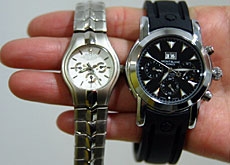want a cheap rolex buddy?

At Beijing's Hongqiao market, thousands of fake Swiss watches are openly on sale, part of a trade that does huge damage to one of Switzerland's biggest exports.
The Federation of the Swiss Watch Industry considers counterfeiting – especially in China – the watchmaking industry’s biggest problem.
“Hello, hello, watch, Rolex” is an offer you’ll hear more than once while wandering through the sprawling Hongqiao market, near one of the Chinese capital’s main attractions, the Temple of Heaven.
Between the socks and the underpants, the cashmere and silk scarves, the computer accessories and the souvenirs, dozens of stalls, some of them set up like small jewellery stores, hawk “brand name” watches, all of them fake.
Every day of the week, many Chinese as well as tourists and foreigners living in the city stroll through the market, eyeing the merchandise and spending along the way.
Rolex, Breguet, Longines, Omega,
Blancpain, Tag Heuer, Patek Philippe, Vacheron Constantin, IWC: all the big names of the Swiss watchmaking industry seem to be here.
“Are they really Swiss?” I ask.
The seller replies that of course they’re not. “Some of them come from Taiwan, others from Shenzen,” he explains.
“But look at this one more closely. It’s really good!”
Shoddy
He shows me a Montblanc automatic model. The bracelet is a giveaway to its origin, made out of some kind of plastic that will break after a few days. But to the layman’s eye, the
watch itself looks solid and has a pleasing dial.
A European woman wanders over to the stall and asks the seller if he has a particular model of Patek Philippe.
A quick check in his catalogue is enough to confirm that it is available and the sale is over in a few seconds.
I’m still discussing quality, which the seller admits varies from watch to watch, and a price. Finally, we agree on a Montblanc plus a women’s Rolex for 200 yuan, just over SFr30.
“You can have the Rolex for 50 yuan (about SFr8), but the Montblanc is better quality,” the
seller says. “I can’t let you have it for less than 150 yuan.”
Business is brisk. I’ve hardly pocketed my acquisition before I see he’s already negotiating with another customer.
Major problem
Hongqiao is hardly an exception by Chinese standards. Sales of counterfeit merchandise, watches or otherwise, is not even under the counter, but a fact of everyday life.
“It’s a major problem for us,” admits Jean-Daniel Pasche, president of the Federation of the Swiss Watch Industry.
“China is the number one producer
and market of counterfeit merchandise.”
The federation has been in contact with the Chinese government, which has promised to cooperate, but the Swiss expect a long drawn-out battle.
Today, there are more fakes than originals for sale, particularly via the internet. There are in fact thousands of online stores proposing counterfeit Swiss watches.
The biggest concern is that sales of fake timepieces will eventually hurt the good reputation of Swiss watches.
“With the help of the local authorities, we have been able to
conduct raids and seize fake merchandise in China,” explains Pasche. “We have managêd to destroy the counterfeit watches and get the producers sentenced.”
But any sense of relief is quickly brushed aside. For every counterfeiter caught, there are plenty ready to take his place, and more fights in store for the federation.
swissinfo, Marzio Pescia in Beijing
Counterfeit “Swiss Made” watches have been around for many years.
Originally, they were produced in Japan, Hong Kong, Thailand and Taiwan.
But today, China is the number one producer of fakes, and the local authorities have only just begun to crack down on counterfeiting.
The Federation of the Swiss Watch Industry reckons sales of fake watches costs the industry around SFr800 million every year.
The Swiss watch industry produces around 25 million timepieces every year.
But at the same time, 40 million fake Swiss watches are produced somewhere around the world.
70 per cent come from Asia, mostly from China.

In compliance with the JTI standards
More: SWI swissinfo.ch certified by the Journalism Trust Initiative
You can find an overview of ongoing debates with our journalists here. Please join us!
If you want to start a conversation about a topic raised in this article or want to report factual errors, email us at english@swissinfo.ch.